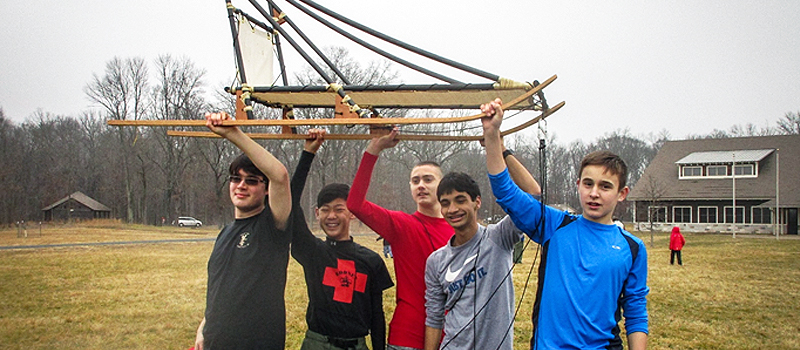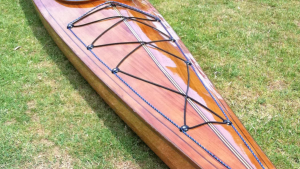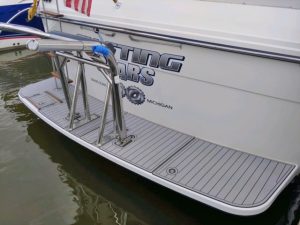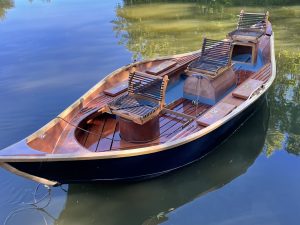
by Tom Dragone, PhD
About the Klondike Derby
The Klondike Derby is an annual winter camping trip held in our district (and many others across the country) for Scouts to hone their scouting skills in a winter environment. During the weekend event, Scout patrols go from station to station around our local Scout Camp, facing challenges that require them to demonstrate their skills in making a fire, navigating with a map and compass, cooking, knot-tying, and applying first aid. The Scouts must bring all their gear with them as they trek from station to station, including ropes, stoves, kindling, and hiking staves. Hence, each patrol is required to have a sled for their gear which they, as a patrol, must haul. The sled must be strong and stiff to hold the patrol gear, yet lightweight because at the end of the weekend there is a race between patrols, and the fastest sled wins.
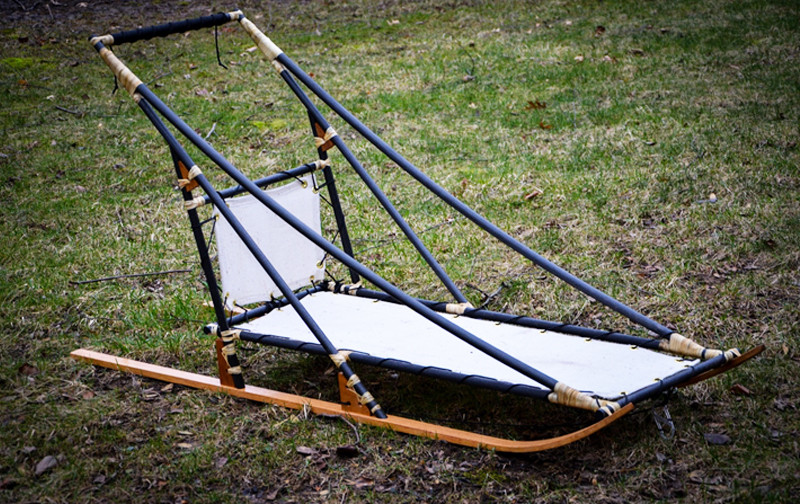
Building a Composite Klondike Derby Sled
The classic Alaskan dogsled consists of bentwood runners, upright stanchions, cross-braces, and a flat bed of slats or stretched canvas. Many of the structural components of the classic dogsled are made from slender wooden components, so I could envision these components being made in composite using braided overwrapped. A&P Technology offers braided fibers in a variety of sizes and material choices. I chose graphite fiber to provide a classic black look and a thick braid of these meant more graphite fibers for strength and stiffness in a single layer. The 1″ diameter braided layer was applied to a ¾” wooden dowel, resulting in a fiber angle slightly less than the nominal 45° to provide more axial stiffness in the components. The wooden core adds to the strength and stiffness of the graphite braid, and the graphite allows a much smaller wooden core than if it were un-reinforced.
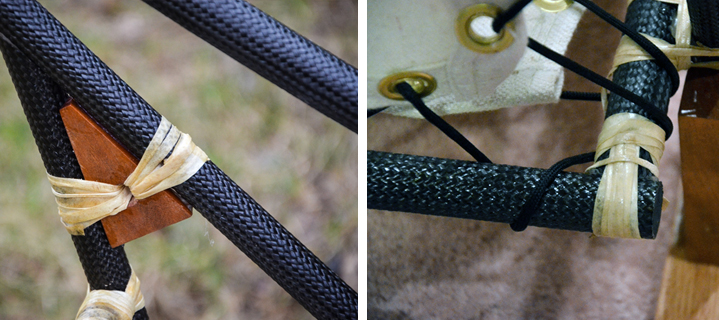
Epoxy Choice and Cure Time
Since I did not have access to an autoclave, the choices for resin materials were limited compared with what I typically use to create aerospace parts in my day job. WEST SYSTEM Epoxies offered ease of use, room temperature curing, and a strong durable finish. Experts at WEST SYSTEM technical support recommended their 105 Epoxy Resin with 207 Special Clear Hardener to create a smooth, clear surface that would not yellow over time.
The Scouts used brushes to apply the epoxy while the stanchion and brace components were hung vertically, thus preventing the epoxy from pooling on one side of the cylinder. The only disadvantage of using 105/207 for this application is it’s slow to cure. To accelerate the cure reaction, I created a simple oven from ½” insulation board and duct tape, heated with four 100W halogen lights. The oven reached about 120°F, reducing the typical 8-hour cure time to 2 hours.
The side rails of the sled presented a particular challenge for this fabrication process because, while they could have been made from straight dowels like the other components, they are typically curved and add significantly to the visual appeal of the design. The solution: a PVC pipe flexible enough to achieve the desired curve. After placing the braid over the PVC, we threaded paracord down the center of the tube and tied back into a loop on itself. Adjusting the tension in the looped cord (with a taut line hitch, as any Boy Scout can attest) held the braided PVC in the desired shape while the epoxy was applied and during cure. Once the epoxy cured, we removed the cord and the braided PVC retained its curved shape.
Composite Sled Construction Techniques
Unlike the hiking staff, which was a single piece, the Klondike sled required multiple pieces to be joined together. Joining composite parts is the most challenging aspect of designing with composites. It can be difficult to get enough bond area in the joints, given the limited size of the components’ cylindrical shape. Therefore, we adapted traditional sled construction techniques, using rawhide strips wrapped through and around the joints. This technique employed the lashing skill the Scouts already knew. We lashed the rawhide while it was wet, and as it dried, it pulled the joint together making it quite a tight fit. The result, as native Americans, fur trappers, and pioneers discovered long ago, is a strong yet flexible joint that can stand up to backcountry abuse.
Composite runners were not in the scope of this project (for this year anyway), so we made them from hardwood 1x3s sliced lengthwise from one end, bent, and re-laminated. Small hardwood blocks fit into the joints and provided the support for the rawhide lashings. Last, we lashed a canvas bed to the composite bed frame, providing an extremely light support surface for gear.
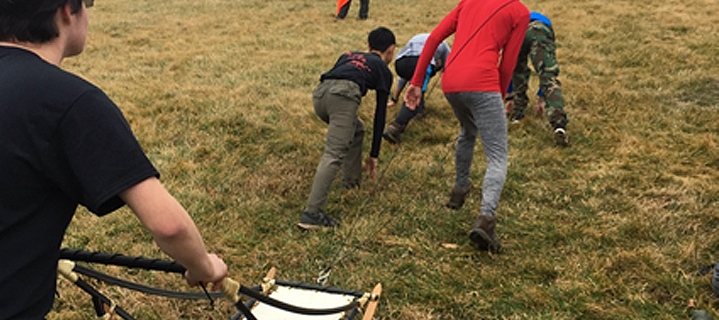
Composite Klondike Derby Sled for the WIN
In the end, our troop was quite pleased with the new Klondike Derby sled. Typical Scout sleds are made from 2x4s and other scrap wood and are built like tanks, weighing as much as 40-50 pounds. Our racing sled weighed in at under 12 pounds. This turned out to be a significant advantage in the short out-and-back race because our sled easily slid around the pylon in the turn while the other, heavier sleds were more difficult to maneuver. In a race that is usually won by less than a sled length, our swift composite racing sled won by at least six sled lengths, demonstrating that a superior sled can be achieved by combining traditional assembly techniques with 21st-century materials.
Dr. Tom Dragone is a Senior Scientist at OrbitalATK, specializing in the application of composite materials in advanced spacecraft and launch vehicle structures. He is also a Merit Badge Counselor and Committee Member for Troop 7369 in Chantilly, Virginia.
Special thanks to A&P Technology for graciously donating the graphite braided tube used in this project.
Editor’s Note: In Epoxyworks 43 we published “Merit Badge,” an article describing a composite hiking staff project for Boy Scouts from Tom Dragone’s local Troop to fulfill the requirements of the Composite Materials Merit Badge. In that project, the Scouts learned about the constituent fibers, matrix materials and processing methods for advanced composites. They also made a hiking staff by applying a braided graphite sleeve over a wooden mandrel, coating it with two-part epoxy and curing it in a low-temperature oven. This resulted in a strong, stiff and lightweight hiking staff that they could take on the trail.

